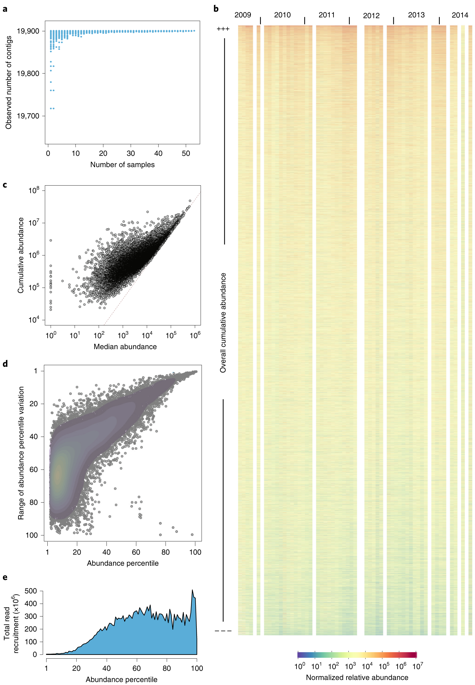当前位置:
X-MOL 学术
›
Nat. Microbiol.
›
论文详情
Our official English website, www.x-mol.net, welcomes your
feedback! (Note: you will need to create a separate account there.)
Long-term stability and Red Queen-like strain dynamics in marine viruses.
Nature Microbiology ( IF 20.5 ) Pub Date : 2019-12-09 , DOI: 10.1038/s41564-019-0628-x J Cesar Ignacio-Espinoza 1 , Nathan A Ahlgren 1, 2 , Jed A Fuhrman 1
Nature Microbiology ( IF 20.5 ) Pub Date : 2019-12-09 , DOI: 10.1038/s41564-019-0628-x J Cesar Ignacio-Espinoza 1 , Nathan A Ahlgren 1, 2 , Jed A Fuhrman 1
Affiliation

|
Viruses that infect microorganisms dominate marine microbial communities numerically, with impacts ranging from host evolution to global biogeochemical cycles1,2. However, virus community dynamics, necessary for conceptual and mechanistic model development, remains difficult to assess. Here, we describe the long-term stability of a viral community by analysing the metagenomes of near-surface 0.02-0.2 μm samples from the San Pedro Ocean Time-series3 that were sampled monthly over 5 years. Of 19,907 assembled viral contigs (>5 kb, mean 15 kb), 97% were found in each sample (by >98% ID metagenomic read recruitment) to have relative abundances that ranged over seven orders of magnitude, with limited temporal reordering of rank abundances along with little change in richness. Seasonal variations in viral community composition were superimposed on the overall stability; maximum community similarity occurred at 12-month intervals. Despite the stability of viral genotypic clusters that had 98% sequence identity, viral sequences showed transient variations in single-nucleotide polymorphisms (SNPs) and constant turnover of minor population variants, each rising and falling over a few months, reminiscent of Red Queen dynamics4. The rise and fall of variants within populations, interpreted through the perspective of known virus-host interactions5, is consistent with the hypothesis that fluctuating selection acts on a microdiverse cloud of strains, and this succession is associated with ever-shifting virus-host defences and counterdefences. This results in long-term virus-host coexistence that is facilitated by perpetually changing minor variants.
中文翻译:

海洋病毒的长期稳定性和类红皇后菌株动力学。
感染微生物的病毒在数量上主导着海洋微生物群落,其影响范围从宿主进化到全球生物地球化学循环1,2。然而,概念和机制模型开发所必需的病毒群落动态仍然难以评估。在这里,我们通过分析来自圣佩德罗海洋时间序列 3 的近地表 0.02-0.2 μm 样本的宏基因组来描述病毒群落的长期稳定性,这些样本在 5 年内每月采样一次。在 19,907 个组装的病毒重叠群中(>5 kb,平均 15 kb),在每个样本中发现 97%(通过 >98% ID 宏基因组读取招募)具有超过 7 个数量级的相对丰度,并且等级的时间重新排序有限丰富性和丰富性的变化不大。病毒群落组成的季节性变化叠加在整体稳定性上;最大的社区相似性每隔 12 个月出现一次。尽管具有 98% 序列同一性的病毒基因型簇具有稳定性,但病毒序列显示出单核苷酸多态性 (SNP) 的瞬时变异和次要种群变异的不断更新,每个变异在几个月内上升和下降,让人想起红皇后动力学 4。从已知的病毒-宿主相互作用的角度解释种群内变异的兴衰,与波动选择作用于微多样化的毒株云的假设是一致的,这种连续性与不断变化的病毒-宿主防御和反抗。
更新日期:2019-12-11
中文翻译:

海洋病毒的长期稳定性和类红皇后菌株动力学。
感染微生物的病毒在数量上主导着海洋微生物群落,其影响范围从宿主进化到全球生物地球化学循环1,2。然而,概念和机制模型开发所必需的病毒群落动态仍然难以评估。在这里,我们通过分析来自圣佩德罗海洋时间序列 3 的近地表 0.02-0.2 μm 样本的宏基因组来描述病毒群落的长期稳定性,这些样本在 5 年内每月采样一次。在 19,907 个组装的病毒重叠群中(>5 kb,平均 15 kb),在每个样本中发现 97%(通过 >98% ID 宏基因组读取招募)具有超过 7 个数量级的相对丰度,并且等级的时间重新排序有限丰富性和丰富性的变化不大。病毒群落组成的季节性变化叠加在整体稳定性上;最大的社区相似性每隔 12 个月出现一次。尽管具有 98% 序列同一性的病毒基因型簇具有稳定性,但病毒序列显示出单核苷酸多态性 (SNP) 的瞬时变异和次要种群变异的不断更新,每个变异在几个月内上升和下降,让人想起红皇后动力学 4。从已知的病毒-宿主相互作用的角度解释种群内变异的兴衰,与波动选择作用于微多样化的毒株云的假设是一致的,这种连续性与不断变化的病毒-宿主防御和反抗。











































 京公网安备 11010802027423号
京公网安备 11010802027423号